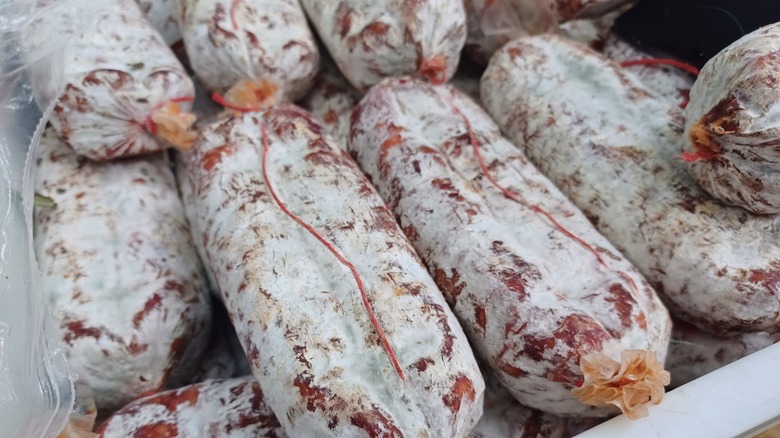Is The White Casing On Salami Actually Mold?
It's hard to go wrong with salami. The salty, savory, and flavor-packed hard sausage is the perfect addition to round out any charcuterie board (or shotcuterie cup). But sometimes when you pull out the salami for that perfect party spread, the casing is covered in a somewhat suspicious powdery white coating. Let's get this out of the way now: Yes, it's mold — but it's the good kind.
Usually, the fluffy white substance coating a hard salami is a specific strain of mold called Penicillium nalgiovense. This white mold is actually considered a sign of quality by many artisanal cured meat experts. It forms a protective coating, preventing the meat from getting too dry or developing toxic kinds of mold.
The official word from the USDA is that surface mold on hard salami or other shelf-stable meats is perfectly normal and these products are safe to use; however, the department recommends scrubbing the mold off the surface prior to consumption.
How to tell if salami has gone bad
Salami is a cured meat, which is preserved by salting, smoking, or air-drying. It is then aged for at least two weeks and up to several months. Due to this preservation process, salami can last quite a while, just waiting for the perfect celebratory moment to garnish your bourgeois charcuterie board. However, like nearly any food, salami can go bad. Per the USDA, hard salami can last indefinitely in the refrigerator before opening, and about three weeks after opening.
But how can you tell the difference between normal surface mold and the bad stuff? The good kind of salami mold is typically white and slightly fluffy and can be easily removed by scrubbing or wiping. The bad kind of salami mold is usually green or black and fuzzy.
As a general rule, if the mold on your salami isn't white, it's probably wise to err on the side of caution and toss it. Another telltale sign that salami has gone off is if it's become wet and slimy or, alternatively, extremely dry and hard -– neither of which sounds very appetizing. And of course, there's always the smell test. If your salami smells like rotten eggs or meat that's gone rancid, or otherwise makes you recoil, please chuck it.
How to use up leftover salami
So often, we crack open a gorgeous, delicious salami for a charcuterie board and then toss it to the back of the fridge and forget about it. Unless you're hosting parties all the time, it's unlikely that you'll use up all your salami in charcuterie spreads before it starts developing the not-so-good kind of mold. Luckily, there are many other great ways to incorporate salami into your diet.
The cured sausage is a favored protein option for hikers and picnickers thanks to its durability and flavor-packed deliciousness. It's also an ideal topping for sandwiches or pizza, and if you're feeling especially fancy, you could even use it to make the viral TikTok grinder salad sandwich. On the lighter side, chopped salami makes an excellent addition to salads and soups. And if all else fails, you can freeze it –- once frozen, hard salami should be consumed within one to two months for the best quality.


